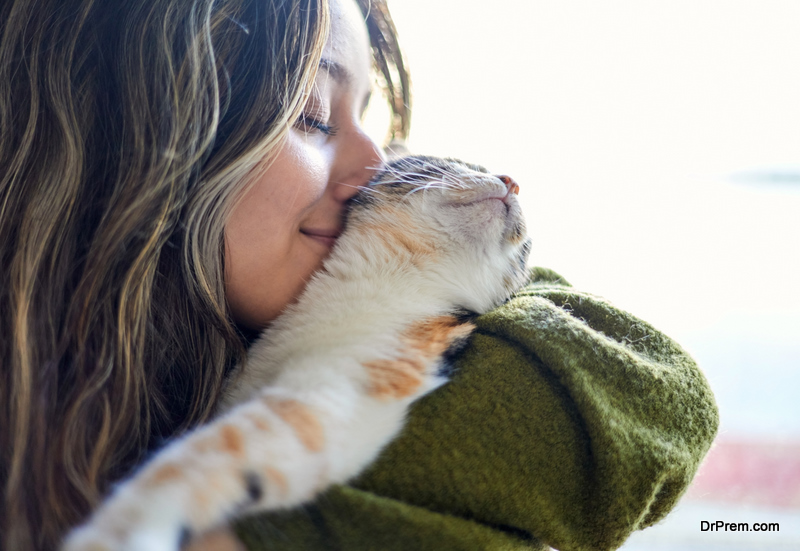Cats are known for being independent creatures. And, if you have one already, this shouldn’t come as any surprise! Unlike dogs, who seem to love petting, playing games, or having just about any interaction with their pet parents, felines tend to keep to themselves.
But, it doesn’t always have to be this way! With time and careful training, you can teach your cat or kitten to enjoy being held!
Yes, not only will they “put up with you” trying to cuddle or carry them, but they’ll actually like it!
There are benefits both to you and your furry family member. Holding pets can relieve stress and anxiety for the pet parent. It can also provide a sense of security for your cat.
And, that closeness can also help you notice immediately if something’s off about your pet or if they seem sick. And, if you have cat insurance, that can make a quick trip to the vet – plus any medications or treatments – a lot easier to pay for.
Plus, a cat that’s okay with being held will have a much better time at the vet.
But, let’s not dwell on the negatives! Instead, we’ll start by explaining a little cat psychology. Then, we’ll get into the tips, tricks, and training strategies you’ll need to make your relationship with your pet a little cozier.
Why Don’t Cats Usually Like To Be Held?
Cats aren’t inherently social creatures like dogs or humans. Their default state is usually to keep to themselves, even when it comes to other felines. After all, when was the last time you saw a pack of stray cats?
Next, getting picked up isn’t something that happens naturally to a cat in the wild. Other felines won’t do that. And they may not be used to humans yet. Therefore, getting scooped up can feel like a sign of danger to your furry friend.
Lastly, and sadly, a cat may not want to be picked up due to trauma earlier in their life. Or, they may be sick or in pain.
In general, the idea behind training a cat is to let them know that it’s natural and okay for you as their pet parent to pick them up. As a bonus, you’ll quickly notice a change in behavior if they’re unwell for some reason.
Training Your Cat To Enjoy It When You Hold Him Or Her
To train a cat to enjoy being held, you’ll need to take some preliminary steps to create the right mood and environment. Once you’ve set the stage, there are simple tips and strategies you can use for this sort of training.
1. Before You Start
The first thing you’ll want to do is ensure your cat is comfortable and relaxed. Choose a room or part of the house your pet already likes and where they spend a lot of time. Make sure it’s quiet and not too hot or cold.
Now, you’re ready to start interacting with them!
2. Inviting
Start by inviting your cat to you. Pat your lap or use the calls you know they respond to well. This process works best if they come to you on their own in the first place. You’ll know they’re comfortable with you and at least open to the interaction.
3. Petting
Once they’re in your lap, pet your cat with long strokes from their ears to their tail. Scratch their ears. Speak to them in a soothing voice while you do this.
You’ll repeat this process for a few days. Get your cat used to it by doing this four times a day for around thirty seconds per session.
After a little while, your cat should begin rubbing her face against your hands. That’s a good sign they’re ready for the next step.
4. Placing
Once you’ve established a routine and comfort level, it’s time to take the next step! Place your hands around your cat’s shoulders for about ten seconds while they’re on your lap. Then, give them a treat and let them jump away from you.
As they become comfortable with this, gently lift one of their paws and then let go. Once again, give them a treat afterward. Repeat this process with other small activities like holding different legs, rubbing their belly, or touching their tail.
This way, you’re gradually increasing her tolerance for being touched on different parts of their body and for more extended periods of time.
This process can take a while! Be patient. Don’t do too much too soon, or try to force your furry family member to do anything they don’t want to do.
5. Playing
Once picking up and handling them is easy and natural, you can have some fun! Cats love chasing toys or playing with string. Play a game in between handling their legs or tails, or rubbing their belly.
Get into a routine of touching and then treating or touching and then playing with them. This process keeps them comfortable. They’ll let you hold them for longer amounts of time and also will let you hold them in different ways.
Once again, be patient! And take a break if your cat seems unhappy, stressed, or agitated.
How To Tell If Your Cat Is Comfortable
How do you know if your training is working? There are some signs to watch for in a comfortable cat.
Purring and even a little drooling are good signs! The same applies if they begin kneading you (sometimes called “making biscuits”).
Vets and animal experts also believe that a cat will close their eyes while looking at you if they trust you. It happens when they don’t fear you as a predator and think they are someplace safe. You can reciprocate by closing your eyes and keeping them closed even after they open theirs.
Even though cats can be solitary creatures, it’s not hard to form a physical bond with your cat or kitten that will make you and your furry family member happy and healthy for years to come!
Article Submitted By Community Writer


